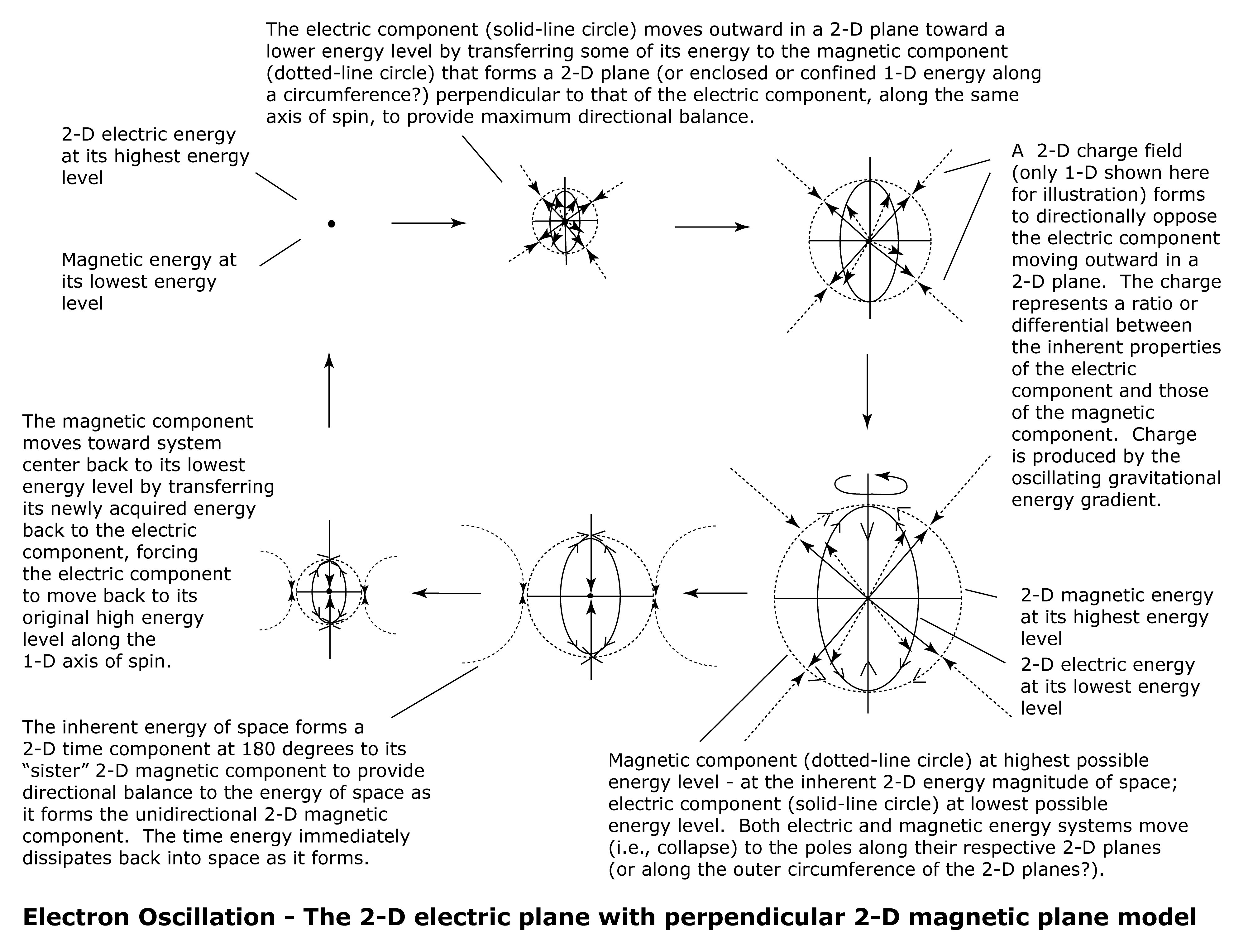 An electron consists of 2-D electric energy moving outward from system center toward a lower energy level (less density). Adjacent inherent energy of space forms opposing 2-D magnetic energy to provide directional balance to the 2-D electric energy.
An electron consists of 2-D electric energy moving outward from system center toward a lower energy level (less density). Adjacent inherent energy of space forms opposing 2-D magnetic energy to provide directional balance to the 2-D electric energy.
The magnetic energy consists of a 2-D plane perpendicular to the 2-D electric energy, the two sharing the same axis of spin, Time energy is formed by the energy of space at 180 degrees to oppose the magnetic energy as it forms to maintain the directional balance of space. The 2-D time energy immediately dissipates back into the energy of space as it forms, providing directional balance to the 2-D magnetic energy while allowing the magnetic energy to provide maximum directional balance to the electric energy.
Once the 2-D magnetic energy reaches its maximum energy level – the inherent energy magnitude of 2-D space – it can proceed no further. The 2-D magnetic energy moves outward at right angles to form a 1-D circle along the circumference or outer boundary of the structure (at the greatest radius from system center). The 2-D electric energy returns to system center along the 1-D axis of spin. Since, a gravitational energy gradient is formed by a varying ratio of potential:kinetic energy of space inward to system center, it can only be produced in 2-D or 3-D space. So the 1-D energy flowing along the axis of spin does not possess a gravitational energy gradient as the particle’s 2-D energy does. As a result, it is the 2-D electric energy that requires more directional balance by the inherent energy of space (i.e., 2-D gravitational energy gradient, 2-D magnetic energy, and 2-D time energy).
The formation of 2-D planes of electric energy and 2-D magnetic energy outward from system center results in a 2-D gravitational energy gradient formed by the inherent energy of adjacent space to provide directional balance to the difference between the density of the 2-D electric energy to that of adjacent 2-D space. The 2-D gravitational energy gradient is produced through an increasing ratio of potential energy of 2-D space to kinetic energy of 2-D space inward toward system center. The strength of the 2-D gravitational energy gradient is highest when the 2-D electric energy possesses its highest energy density. As the 2-D electric energy moves outward from system center, the 2-D gravitational energy gradient becomes weaker. The strength of the 2-D gravitational gradient oscillates or vibrates with the electromagnetic (e-m) interaction of the electron.
The oscillating 2-D gravitational energy gradient produces a ‘charge’ field about the non-entangled 2-D e-m electron. The magnitude of the charge is due to a ratio of the inherent properties of 2-D electric energy to that of 2-D magnetic energy. In other words, charge is a ratio of the inherent properties of 2-D unidirectional (i.e., electric or nonrandom) energy to that of the inherent directionally balanced (i.e., random) energy of 2-D space. The magnitude of the 2-D gravitational energy gradient, similarly, is due to the difference between the density of 2-D unidirectional (i.e., electric) energy relative to the inherent energy density of adjacent 2-D space.
(This structure is based on the need for the unidirectional 2-D energy, or charged electron energy, to recycle. In the case of entangled e-+ particles (i.e., electron/positron particles with alternating e-m directionality with every e-m interaction), recycling is not necessary. Instead the entangled particles with opposing e-m directionality are directionally balanced and interchange identities with every e-m interaction. Recycling of energy is not necessary. Recycling of energy only occurs in an non-entangled, charged electron. )
The electron represents a lower energy structure than a positron because its 2-D electric energy moves from a higher energy level (higher density to a lower energy level (lower density) – like a river flowing down hill.
Spin.
‘Spin’ is a quantum property that is most likely due to the property differences between the 2-D electric energy and its corresponding 1-D electric energy (along the system axis of spin).
Formation of a charge field
In the case of an non-entangled, or isolated, electron, its 2-D electric energy moves outward from system center toward a lower energy level. As it moves outward, it pushes against the inherent energy of 2-D space, resulting in higher pressure at the boundary. The energy density of the 2-D electron relative to that of the inherent energy of 2-D space is directionally balanced by the formation of a 2-D gravitational energy gradient through an increasing ratio of potential:kinetic energy of space inward toward system center.
In the case of an non-entangled, or isolated positron, its 2-D electric energy moves inward to system center toward a higher energy level. As it moves inward, it pulls away from the inherent energy of 2-D space, resulting in lower pressure at the boundary. As with the electron, the energy density of a 2-D positron relative to that of the inherent energy of 2-D space is directionally balanced by a 2-D gravitational energy gradient formed through an increasing ratio of potential:kinetic energy of space inward toward system center.
As the 2-D electric energy of an electron moves outward from system center, it moves from a region of high ratio of potential:kinetic energy of space at system center to lower ratio of potential:kinetic energy of space at the outer boundary of the particle (where the 2-D magnetic energy reaches its highest possible energy level).
On the other hand, as the 2-D electric energy of a positron moves inward to system center, it moves from a region of lower ratio of potential:kinetic energy of space at the outer boundary of the particle to a higher ratio of potential:kinetic energy of space at system center.
The direction of movement of the 2-D electric energy is opposite for the electron and the positron so the oscillation or vibration of their gravitational energy gradients are also in the opposite direction. In the case of an electron, the oscillation of its gravitational energy gradient moving outward from system center produces a negative charge field. For a positron, the oscillation of its gravitational energy gradient moving inward to system center produces a positive charge field.

